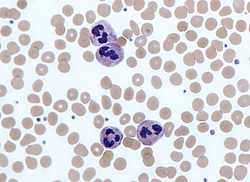Neutrophilia
| Neutrophilia | |
|---|---|
 Neutrophils with a segmented nuclei surrounded by erythrocytes, the intra-cellular granules are visible in the cytoplasm (Giemsa stained) | |
| Classification and external resources | |
| DiseasesDB | 8995 |
| eMedicine | med/3209 |
Neutrophilia (or neutrophil leukocytosis) describes a high number of neutrophil granulocytes in blood.[1]
Causes
Neutrophils are the primary white blood cells that respond to a bacterial infection, so the most common cause of neutrophilia is a bacterial infection, especially pyogenic infections.[2]
Neutrophils are also increased in any acute inflammation, so will be raised after a heart attack,[2] other infarct or burns.[2]
Some drugs, such as prednisone, have the same effect as cortisol and adrenaline (epinephrine), causing marginated neutrophils to enter the blood stream. Nervousness will very slightly raise the neutrophil count because of this effect.
A neutrophilia might also be the result of a malignancy. Chronic myelogenous leukemia (CML or chronic myeloid leukaemia) is a disease where the blood cells proliferate out of control. These cells may be neutrophils. Neutrophilia can also be caused by appendicitis and splenectomy.[3]
"Left shift"
A "left shift" refers to the presence of increased proportions of younger, less well differentiated neutrophils and neutrophil-precursor cells in the blood. This generally reflects early or premature release of myeloid cells from the bone marrow, the site where neutrophils are generated. A severe neutrophilia with left shift is referred to as a leukemoid reaction. The leukocyte alkaline phosphatase (LAP) score, which refers to the amount of alkaline phosphatase per neutrophil, will increase. In a severe infection, toxic granulation changes happen to the neutrophils.
This can resemble Pelger-Huet anomaly.[4][5]
See also
- Granulocytosis (often used as synonym)
- Neutropenia (having too few neutrophils)
- Absolute neutrophil count
References
- ↑ "neutrophilia" at Dorland's Medical Dictionary
- ↑ 2.0 2.1 2.2 Table 12-6 in: Mitchell, Richard Sheppard; Kumar, Vinay; Abbas, Abul K.; Fausto, Nelson. Robbins Basic Pathology. Philadelphia: Saunders. ISBN 1-4160-2973-7. 8th edition.
- ↑ "bloodandcancerclinic". Retrieved 10 April 2013.
- ↑ Mohamed IS, Wynn RJ, Cominsky K et al. (June 2006). "White blood cell left shift in a neonate: a case of mistaken identity". J Perinatol 26 (6): 378–80. doi:10.1038/sj.jp.7211513. PMID 16724080.
- ↑ Shmuely H, Pitlik SD, Inbal A, Rosenfeld JB (June 1993). "Pelger-Huët anomaly mimicking 'shift to the left'". Neth J Med 42 (5–6): 168–70. PMID 8377874.
| ||||||||||||||||||||||||||||||||||||||||||||||||||||||||||||||